Muzzleloader Hunting Wyoming Pronghorn
Muzzleloader hunting in Hanna, Wyoming. This historic coal mining town is nestled in a land where deer and antelope play. It’s also the home of author and black powder authority Dr. Sam Fadala. When Sam invited me to hunt pronghorn with him on his home turf I jumped at the chance, and eagerly sent my application and five preference points off into cyberspace with the hope of drawing a tag. Wyoming holds the world’s largest pronghorn population – numbering nearly half a million animals – and Hanna is strategically positioned in the heart of Carbon County, revered among enthusiasts as the #1 county in the U.S. for producing record book pronghorn.
The day my tag arrived I contacted Knight Rifles to order a new Ultra-Lite muzzleloader. After all, I would be hunting with the man who wrote the book on black powder (literally), so the powder I needed to use on this hunt would be the smoky black variety, of course! On arrival, the rifle was topped with a new Burris Fullfield E1 scope in 4.5-14×42 with a big 30mm tube, and Ballistic Plex reticle featuring cascading windage and elevation dots to facilitate long-range shooting. There is always the possibility that a long shot may be necessary when hunting these wary speedsters on open prairie lands, so I needed to make sure that the new rifle and I were both up to the task. Surprisingly, it took only a couple of hours at the local range to work up a powerful yet remarkably accurate load for the new Ultra-Lite.
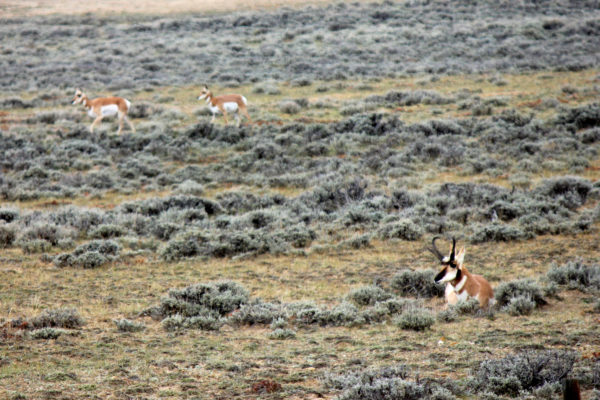
This would be my first time muzzleloader hunting pronghorn in Wyoming, and I was eager to see for myself if Wyoming’s version of the “speed-goat” was indeed larger than the variety I hunted in my home state of Arizona. Although I typically hunt for mature animals and often hold out for “trophy” size as well, Wyoming was suffering from an extreme drought that had been devastating for antelope herds. Bone-dry conditions persisted in the area we would be hunting in southern Wyoming, taking a toll on natural forage as well as horn (and antler) growth. The good news from the local U.S. Fish & Wildlife predator control agent was that finding a mature pronghorn buck would not be difficult. The bad news was that finding a buck in our hunt area with “trophy” size horns would be uncharacteristically difficult.
Approaching from the west near the end of my 800-mile drive from eastern Arizona, the town of Hanna was unmistakable. Nestled in the center of one of Wyoming’s largest and richest coalfields, the small town was seemingly dwarfed by a colossal old dragline sitting idle on the hillside above – a tribute to men who toiled and perished in the mines. Sam had secured permission for us to hunt on two large ranch properties nearby, and I believe he was just as anxious to show me around as I was to see the local country and animals. We spent that first afternoon driving the back roads and looking over herd after herd of pronghorn. Scores of giant wind machines stretched across the southern access point to the property and watching the colorful antelope as they wandered among the propeller topped towers afforded striking visualizations that were both memorable and photogenic.
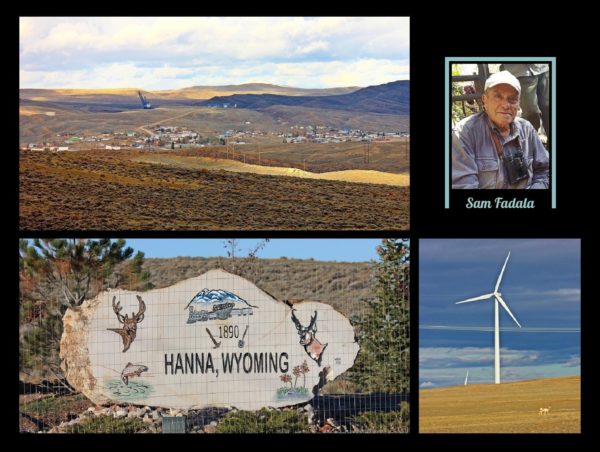
Circumstances dictated a more cautious approach to this hunt than the norm, as Sam was recovering from the effects of a head-on car collision in Zimbabwe that all parties involved had miraculously survived, though not without serious injuries. Our plan was to road-hunt, primarily to locate a target animal, and then make the final approach on foot using the wind and whatever natural cover might be available. Since the drought-stricken native vegetation was thin and unusually short, it appeared that stalking within muzzleloader range of the eagle-eyed pronghorn would present a formidable challenge. The sub-freezing morning temperatures and 30+ mph winds would further complicate matters, and this expectation was validated on my very first stalk. We bumped a small herd mid-morning that quickly disappeared over a ridge half a mile away. A heavy-horned and exceptionally dark-faced buck trailed the group, so I grabbed my pack and muzzleloader and followed. The hike up was surprisingly calm and quiet, but as I crested the top of the ridge the gusting wind almost blew me over!
Our travel and searching on the second day of the hunt took us eastward toward the town of Medicine Bow. We looked over hundreds of antelope that day and just as the predator control agent predicted, none of them sported outsized horns. Despite the fact that there was still some late rutting activity this third week in October, nary a 15-inch buck could be found! I thought it was interesting that we could drive right up to some of these animals, while others raced off at the sight of the truck – even at distances of more than a mile. It appeared that young antelope, alone or in small groups, were not alarmed by vehicles. If however, a mature buck or seasoned doe was present, the entire herd was off and running with the very first glimpse.
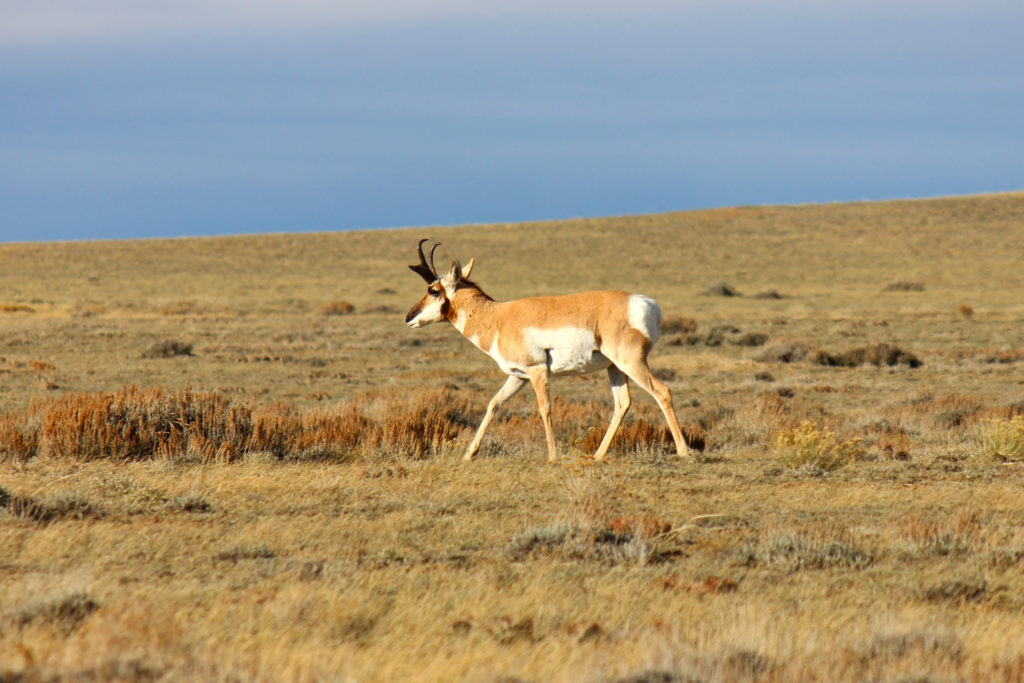
Just before dark, we located a small herd with a large bodied, heavy horned buck near a railroad grade that provided some topographic relief in the otherwise flat and featureless plain. We watched them for a while and I visualized a possible approach, as this buck was as good as any we had seen. The next morning we parked the truck out-of-sight behind the railroad grade, and I crawled up the embankment for a peek. Luck was with us, as the small group had not moved much overnight. Some were up feeding and some were still bedded on this brisk 17-degree morning. I loaded a video camera and a small tripod then shouldered my pack and muzzleloader, while Sam settled in with a good book to wait in the truck. The approach required a 3/4 mile hike using the cover of the railroad grade in the exact opposite direction from the antelope, toward the rising sun. At the end of the grade, I carefully crossed 70 yards of an open flat that was visible to some of the animals. Despite moving slowly and more than a mile distant, one of the bedded does spot me and stood up. She was looking directly into the sun and fortunately did not spook. Reaching the shallow wash that would provide cover for my approach I hoped that the buck would be within range when the cover ran out, as brush in this area was hardly tall enough to hide a rabbit!
When brushy cover ran out, I crawled 20 yards to line up with a small rock pile positioned between me and the feeding animals. Closing the remaining 200 yards to the rocks required crouching, duck walking, crawling, or some combination thereof. A half-dozen two-foot tall bushes provided the last bit of cover. Crawling up, and then carefully peeking through, I spotted the antelope facing away. They were still more than 300 yards out – already beyond my comfortable range and moving farther away. The freshening, gusting wind precluded the possibility of taking a shot over 200 yards, and none of the covers between my position and the animals was taller than six inches. Frustrated, I sat there contemplating my rather limited options: (1) sit tight and hope they changed direction, or (2) crawl after them. The latter was not practical, as they would likely spot me and besides, the browsing herd was covering ground much faster than I could crawl!
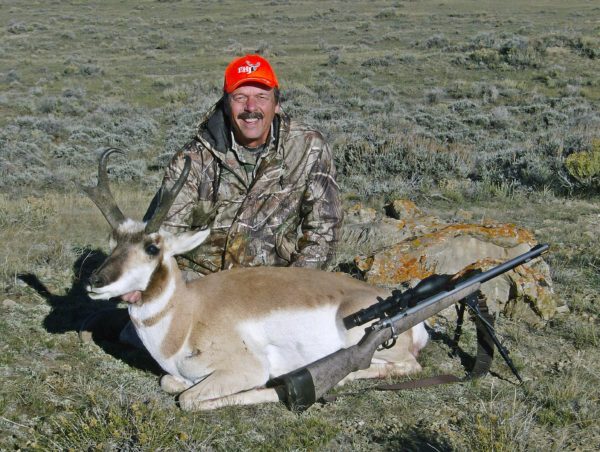
It was looking like I would need a miracle… and ten minutes later one arrived, in the form of a white service truck that drove onto the railroad grade a mile away. The herd got nervous and the lead doe did an about-face, and then bolted about a hundred yards back toward me. The others quickly followed, and I spotted the heavy-horned buck as they stopped in a tight bunch. Now I had a different problem – the bipod mounted on the forend of the Ultra-Lite was too short to clear my cover bushes, and I was reluctant to attempt a free-hand shot at 200+ yards in the wind. Suddenly the entire herd exploded, running flat-out directly at me! I dropped flat in the sand and assumed a prone shooting position, looking directly over the top of the big Burris scope. Within seconds the lead doe blew by no more than fifteen feet away. Thoughts of being trampled by the fleeing antelope flashed through my mind. The second and third does passed, each a little farther away. The next animal that came into view was the buck that I wanted. In that split second – and without consideration of my 1-shot rifle choice – I found his streaking form in the scope while rotating the gun hard right, and touched the trigger just as the crosshairs moved clear of his chest.
For the next few minutes feelings of awe, and then disappointment ran through me – not for missing the shot which had found its mark, but for failing to set up the camera and tripod before the action started – as I had just missed the video opportunity of a lifetime! The perfect 72-yard shoulder shot caused the flat-out buck to nosedive in spectacular fashion, carving a four-foot long ditch in the sand with his horn before tumbling to a dead halt. Sadly, I wouldn’t be able to share the exciting action visually with Sam, who sat patiently waiting for news in the truck. It was no small consolation, however, that I had my first Wyoming pronghorn buck – a beautiful big-bodied animal with horns large enough to place him near the middle of the 400+ entries in the Longhunter muzzleloader record book!
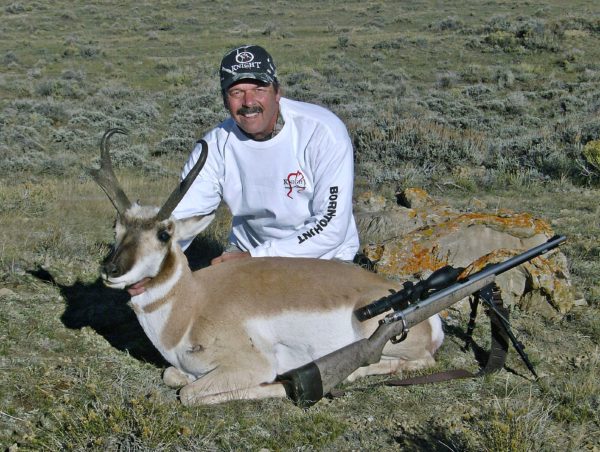
After photos – in both hunting attire, and wearing a Knight hat and shirt carried in my pack – field dressing, packing the animal out, and some clean up at Sam’s house, we toured a few spectacular local attractions. These included 11,150-foot Elk Mountain and the Snowy Range in the Medicine Bow National Forest, and the legendary “Miracle Mile” – actually 5.5 miles of trout fishing paradise on the North Platte River. Next morning we set out to find a pronghorn to fill Sam’s buck tag (and freezer), and it didn’t take long to locate a nice buck that met his criteria. As would be expected of a master outdoorsman who has taken scores of antelope, Sam dropped this buck in its tracks, despite his limited mobility and ten broken ribs. The only surprise was his choice of weapon – a custom centerfire rifle in wildcat .240 Gibbs! What? No black powder? It seems that Sam’s brother had always admired this beautiful custom rifle from McGowen in Kalispell, Montana, and Sam wanted to take one more animal with the rifle before gifting it to him. To be sure, there are very few men in this world like Sam Fadala, and I’m privileged to call him my friend. I owe Sam many thanks; for the friendship and for the incomparable hospitality as my host for this wonderful Wyoming adventure.
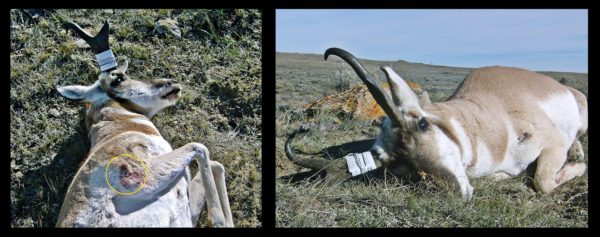
Loading for Pronghorn
With abundant pronghorn in our unit 47 hunt area, I was hoping to show off the accuracy of the new Knight Ultra-Lite muzzleloader by cleanly harvesting my animal with a long shot of 200 yards or more. Unfortunately, the weather (gusting winds) and circumstances (little cover to hide in and ultimately, spooked running animals) foiled my plan. To facilitate my objective, however, I chose a 195-grain Duplex Dead Center bullet manufactured by Precision Rifle in Canada. This .357 caliber bullet is nestled in two plastic sabots for use in .50 caliber rifles, and is touted as the “world’s flattest shooting muzzleloader bullet.” Although care is required for concentric loading, my personal testing would support this claim. Propelled by 90 grains of Blackhorn 209 powder and ignited by a Winchester 209 shotshell primer housed in a Knight Full Plastic Jacket, this loading produced 1-1/4 inch 3-shot groups at 150 yards at the range. I added 10 grains of powder for my hunting load, and the aero-tipped lead bullet passed cleanly through both shoulders of my husky Wyoming buck, with a lethal result that was practically immediate. The 6-pound Ultra-Lite handles more like a quick pointing shotgun than a muzzleloading rifle, and this factor coupled with the clear, bright image in the Burris Fullfield E1 scope, enabled me to make the difficult running shot with confidence.
By Tony Martins, submitted to Knight Rifles for online publication, January 2019. All rights reserved.
